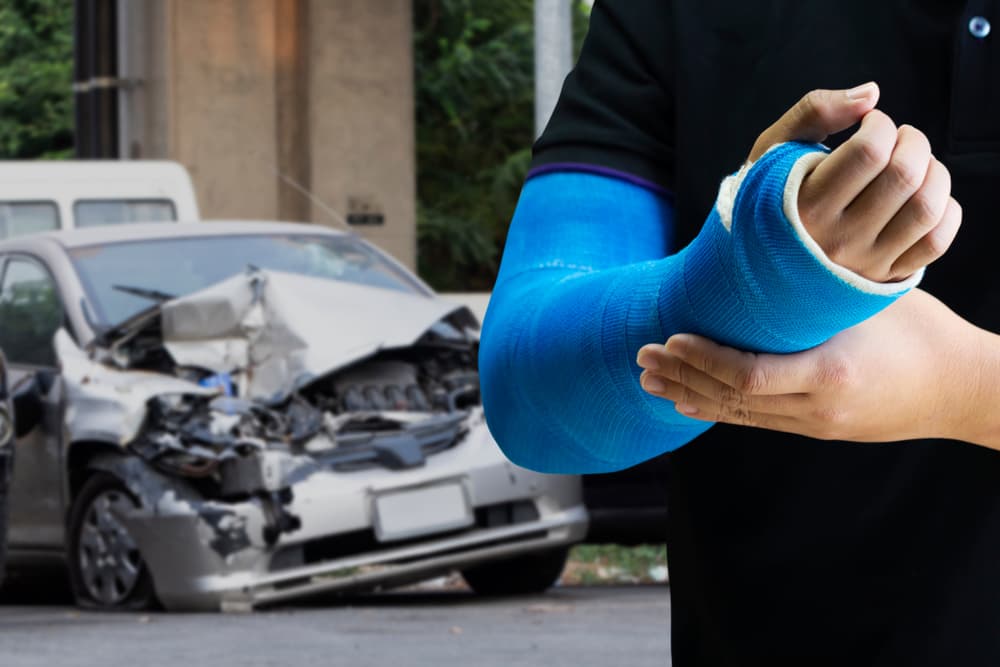Stephen Hasner | Car Accidents | November 18, 2024

The time you have to claim injury after a car accident depends on the statute of limitations in your state, typically ranging from one to four years. It’s imperative to file your claim within this timeframe to preserve your right to seek compensation.
An experienced car accident lawyer can gather evidence, negotiate with insurance companies, and ensure that all necessary documents are filed correctly and on time. They can also assess the full extent of your damages and advocate effectively on your behalf throughout the legal process.
How Do Negligent Drivers Cause Car Crashes?
 Car accidents often happen because of other drivers’ mistakes. The most common ways they cause accidents include distracted driving, speeding, driving under the influence, and not following traffic laws.
Car accidents often happen because of other drivers’ mistakes. The most common ways they cause accidents include distracted driving, speeding, driving under the influence, and not following traffic laws.
Distracted driving, for example, has become a leading cause of accidents, with drivers often focusing on phones, GPS devices, or eating while behind the wheel. Taking even a second to glance at a text message can mean taking eyes off the road and hands off the wheel, leading to crashes. Speeding is another major cause, as driving over the speed limit reduces a driver’s ability to stop in time and increases the chance of losing control.
Driving under the influence of alcohol or drugs slows reaction time and affects judgment. Drivers may think they can handle the road, but their ability to make quick and correct decisions decreases significantly.
Failing to follow traffic laws, such as ignoring stop signs or running red lights, also leads to accidents. Many drivers may feel in a hurry, but breaking these rules puts others on the road at risk.
The most common types of accidents that result from these behaviors include rear-end collisions, side-impact crashes, and head-on collisions. Rear-end collisions frequently happen due to distracted driving or tailgating, where a driver does not leave enough space between cars. If the front vehicle stops, the car behind may be unable to stop in time, causing a crash.
Side-impact collisions, or T-bone accidents, happen at intersections when a driver runs a red light or stop sign and crashes into the side of another vehicle. These crashes can be especially dangerous because the sides of vehicles offer less protection than the front or back.
Head-on collisions, although less common, are often deadly and happen when one driver crosses the center line or drives the wrong way, typically due to distractions, alcohol, or drugs. These crashes occur with a lot of force because both vehicles are moving toward each other, which greatly increases the impact.
What Are the Most Serious Car Accident Injuries?
Car accidents due to other drivers’ negligence can lead to very serious injuries, sometimes with life-changing effects. The most severe injuries include traumatic brain injuries (TBI), spinal cord injuries, internal injuries, broken bones, and severe burns. Each type of injury can vary in seriousness, but all of them require immediate medical attention and often long-term treatment.
- Traumatic brain injuries, or TBIs, are among the most serious injuries from car accidents. When a person’s head hits an object or is jolted severely, the brain can be damaged. TBIs can cause problems with memory, thinking, and emotions. In the most severe cases, they may lead to permanent disability or even death. TBIs often require extensive therapy and rehabilitation, and recovery can be slow.
- Spinal cord injuries are also common and very serious. The spinal cord carries signals from the brain to the body, so any damage to it can result in loss of sensation, movement, or even paralysis. Some car accident victims may experience paraplegia (paralysis of the lower body) or quadriplegia (paralysis of all four limbs). These injuries change a person’s life, often requiring lifelong care and assistance.
- Internal injuries are another serious risk in car collisions. When a strong force hits the body, internal organs like the liver, lungs, or kidneys can become injured. These injuries are dangerous because they may not be visible right away, but they can lead to life-threatening complications if not treated quickly. Internal bleeding is especially serious because it can be fatal if not addressed promptly.
- Broken bones are also common in serious car accidents. While broken bones are treatable, certain fractures, like those in the legs, arms, or ribs, can be complicated. Some fractures may require surgery, physical therapy, and long recovery times. In severe cases, broken bones can lead to permanent physical limitations.
- Burns are another possible outcome, especially if the car catches fire after a crash. Burns are painful and can lead to scarring, disfigurement, and sometimes infections. Severe burns often need extensive treatment, including skin grafts and reconstructive surgeries.
What Is the Statute of Limitations for a Car Accident Claim, and What are Some Exceptions?
The statute of limitations for a car accident lawsuit refers to the legal time limit within which an injured party can file a lawsuit for damages. This period varies by state but typically ranges from one to four years. In most states, the clock starts ticking on the date of the accident. If an injured person fails to file within this time frame, they usually lose the right to pursue compensation through a lawsuit. This rule aims to ensure that cases are brought while evidence is fresh and reliable, helping to achieve fair resolutions.
However, there are some important exceptions to the statute of limitations, which can extend or “toll” (pause) the deadline in certain situations. One common exception is the “discovery rule,” which applies if an injury from the accident is not discovered right away. For example, some injuries, like traumatic brain injuries or internal injuries, may not show immediate symptoms. If a person becomes aware of their injury only later, the statute of limitations may begin from the “discovery date” rather than the accident date.
Another exception involves cases where the injured party is a minor. In most states, if the injured person is under eighteen, the statute of limitations may be tolled until they reach the age of majority. For example, if a minor is injured in a car accident, the time limit for filing a lawsuit may not start until they turn eighteen, giving them a chance to seek compensation even if the accident happened years before.
Finally, mental incapacitation can also toll the statute of limitations. If a person is unable to make legal decisions due to a mental disability or severe injury from the accident, the clock may not start until they regain capacity. In some cases, if the person never fully regains mental capacity, their representative may file a lawsuit on their behalf.
It’s important for accident victims to understand these rules to protect their rights and seek timely legal advice when necessary.
What Happens During a Car Crash Lawsuit?
A car accident lawsuit typically begins with a thorough investigation of the circumstances surrounding the accident. After an accident occurs, both parties involved will gather evidence, which may include police reports, witness statements, photographs of the scene, and medical records. This initial investigation is vital for establishing liability – determining who was at fault for the accident. Insurance companies will also conduct their investigations, gathering their evidence to decide on claims.
Once sufficient evidence is collected, the injured party, known as the plaintiff, will usually consult with a personal injury attorney to evaluate the case and determine the viability of a lawsuit. The lawyer will assess damages, which may include medical expenses, lost income, pain and suffering, and property damage. If the plaintiff decides to move forward, the car accident attorney will file a complaint in the appropriate court, officially starting the lawsuit.
Following the filing, the court will serve the defendant with a summons and complaint. The defendant typically has a specific timeframe to respond to the complaint, usually twenty to thirty days. In their response, the defendant may admit or deny the allegations and may even file counterclaims against the plaintiff.
After both sides have exchanged their initial pleadings, the discovery phase begins. This phase involves both parties collecting additional evidence, which may include depositions (sworn testimonies), interrogatories (written questions), and requests for the production of documents. Discovery is critical for both sides to understand the strengths and weaknesses of the case, allowing them to prepare for potential settlement negotiations.
Once discovery is complete, both parties may enter negotiations to reach a settlement. Many car accident cases are resolved through settlement discussions, where the plaintiff and defendant agree on a compensation amount without going to trial. Settlement negotiations can happen at any point during the lawsuit, even up to the day of trial.
If the parties cannot reach a settlement, the case will proceed to trial. During the trial, both sides present their evidence and arguments before a judge or jury. Witnesses may testify, and both parties will have the opportunity to cross-examine them. After hearing the case, the jury (or judge, in a bench trial) will deliberate and reach a verdict, determining liability and the amount of damages, if any, that the plaintiff will receive.
Alternatively, parties may choose to pursue alternative dispute resolution (ADR), such as mediation or arbitration. These methods can be less formal and quicker than a trial, allowing both sides to reach a resolution with the help of a neutral third party.
What Types of Car Accident Damages Can You Recover?
 In a car collision lawsuit resulting from someone else’s negligence, victims may seek compensation to recover their losses. These damages aim to address both the financial burdens and the emotional effects of the accident. The most common losses include medical expenses, lost income, property damage, pain and suffering, and sometimes punitive damages.
In a car collision lawsuit resulting from someone else’s negligence, victims may seek compensation to recover their losses. These damages aim to address both the financial burdens and the emotional effects of the accident. The most common losses include medical expenses, lost income, property damage, pain and suffering, and sometimes punitive damages.
- Medical Expenses – Compensation for medical expenses covers all costs related to medical treatment, including hospital stays, surgeries, physical therapy, medications, and any future medical care needed as a result of the accident. If the injured party requires ongoing treatment, such as rehabilitation or specialist care, these costs can add up quickly.
- Lost earnings – When an accident prevents a victim from working, they may be entitled to compensation for lost income and loss of earning capacity (for example, if their injury affects their ability to work long-term). Documenting lost income often requires pay stubs, tax returns, or employer statements.
- Property Damage – Compensation for property damage covers the cost of repairing or replacing the victim’s vehicle and any personal property damaged in the crash, such as electronics or personal belongings. An accurate assessment of property damage is essential for determining the appropriate compensation amount.
- Pain and Suffering – This loss addresses the physical and emotional distress that the accident and resulting injuries have caused. Pain and suffering damages are more subjective and may consider factors like the severity of the injuries, the effect on the victim’s daily life, and the emotional toll. Courts often use various methods to calculate these damages, such as multiplying medical expenses or using a per diem approach.
- Emotional Distress – In addition to pain and suffering, victims may seek compensation for emotional distress, which encompasses anxiety, depression, and psychological trauma related to the accident. Evidence of therapy sessions, counseling, or expert testimony may support claims for emotional distress.
- Punitive Damages – Although less common, punitive damages may be awarded in cases involving particularly reckless or malicious behavior, such as driving under the influence or road rage. These damages aim to punish the negligent party and deter similar behavior in the future. Punitive damages are typically awarded in addition to compensatory damages and are not guaranteed.
Understanding these types of damages can help victims effectively pursue their claims and achieve the financial recovery they need to move forward after an accident.
Speak with a Knowledgeable Car Accident Lawyer Today
If you suffered injuries in a car crash that a negligent driver caused, a skilled personal injury attorney can handle the legal process for you. They can file a claim or lawsuit in a timely manner, negotiate with insurance company adjusters, and, if necessary, resolve your case at a trial or alternative dispute resolution proceeding. Your lawyer will work hard to maximize the compensation you receive for all of your accident-related losses.


